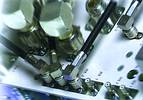Innovative adapter allows reliable, high-volume and automatic testing in mass production
27 February 2002
Interconnection

Huber Suhner's new QMA floating adapter satisfies the exacting requirements that test and measurement components are expected to meet during intensive testing of assemblies or systems in mass production. In addition to fast and reliable connections with superior electrical characteristics, such applications also demand extremely high stability with regard to the mating and unmating cycles.
The company's QMA floating adapter allows testing of assemblies or systems equipped with the new QMA connectors to be automated. The adapter fulfils this requirement by absorbing radial and axial misalignments and shifting them to the 'float' area of the connector which consists of a spring pack.
The Suhner QMA is a recently launched interface designed for applications such as the equipment of infrastructures in the mobile communications market. This is a subminiature connector type that can be used up to 6 GHz as an alternative to the SMA connector, which has resulted in a wide range of potential uses. To complement and support the QMA family, test components are now also available with the QMA interface. These include the QMA floating adapter and the associated phase matched adapter for calibration plus a QMA termination. This unlocks a number of possibilities in application, for example for easy testing of assemblies.
The QMA floating adapter emerged from the search for an optimal connection solution for automatic test systems. The component satisfies the high demands that are placed on test and measurement components during intensive, high-volume testing in mass production. The most essential of these is fast and dependable connection, maintaining excellent electrical characteristics and an extremely high stability with regard to the mating and unmating cycles. This is accomplished by shifting any radial and axial misalignments to the 'float' area of the adapter.
Benefits
On the one hand, the floating adapter reduces the time needed for connecting and disconnecting the device under test (DUT). This increases the cycle time during automatic testing. On the other, it diminishes wear of the interfaces of test components (adapters as well as cables) and of the DUT by offsetting parallel, axial and angular misalignment. Lower wear increases the useful life of the test components in the test system. This, in turn, diminishes the cost of replacing them as well as the number of system stops necessary for installing and recalibrating new components. Finally, several adapters can be used simultaneously and in parallel in multiport applications, since the QMA floating adapter is self-centring.
For further information, contact Dartcom, 012 665 2771.
Further reading:
Understanding and controlling impedance in high-speed interconnects
Spectrum Concepts
Interconnection
[Sponsored] As data rates move well into the hundreds of gigabits per second, success increasingly depends on an invisible but critical factor: impedance.
Read more...
Low profile spring-loaded connectors
Spectrum Concepts
Interconnection
Mill-Max has announced the introduction of low-profile, surface mount additions to its 2 mm pitch spring-loaded connector range.
Read more...
Prefitted junction box solutions
Interconnection
Prepopulated junction boxes in popular terminal configurations, such as single- and three-phase, enhance convenience for both electrical wholesalers and contractors.
Read more...
Bulgin unveils new range of sustainable connectors
Avnet Abacus
Interconnection
The Standard Vitalis Buccaneer range of waterproof connectors is a bio-based alternative to Bulgin’s flagship series, the Standard Buccaneer, offering the same technical performance with improved sustainability.
Read more...
Possible copper cable crisis looms as global demand soars
Interconnection
With the world requiring up to 3 billion metric tons of copper by 2050 to support green energy transitions and developing nations’ infrastructure, far exceeding the 23 million metric tons mined in 2024, pressure on supply chains is mounting.
Read more...
High-reliability spring-loaded interconnects
Spectrum Concepts
Interconnection
These springs from Mill-Max are drop-in replacements for the standard springs, requiring no changes to the form or fit of the existing spring-loaded pins.
Read more...
Anoison PCB mount connectors for high-performance applications
Conical Technologies
Interconnection
With its wide selection, Anoison provides PCB mount connectors that combine precision, durability, and cost-effectiveness across industries.
Read more...
Connectors for the Smart Factory
Spectrum Concepts
Interconnection
[Sponsored] Designing networks for the smart factory can seem daunting, but the solutions are already available with Samtec providing a comprehensive range of interconnect technologies tailored to the demands of the modern factory.
Read more...
Mouser shares expert design solutions for advanced robotics development
Interconnection
Mouser Electronics has announced a new interactive eBook, ‘The Electric Workforce’, in collaboration with electronics manufacturer and connectivity innovator, Molex.
Read more...
Explosive zone connectors
Interconnection
The connector series design by Glenair is optimised for fast and easy crimp-contact wire termination, with ample wiring space in the cable housing and accessory hardware.
Read more...


